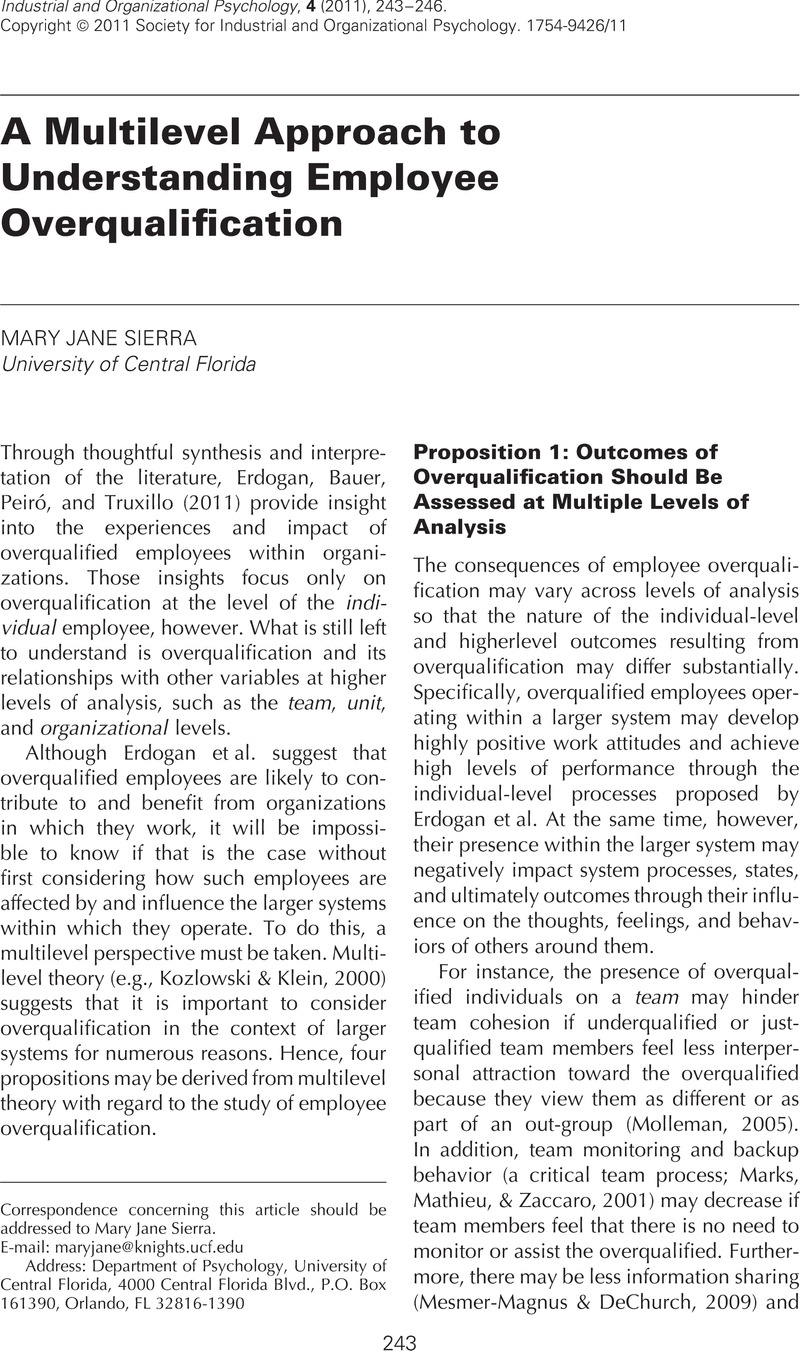Crossref Citations
This article has been cited by the following publications. This list is generated based on data provided by Crossref.
Erdogan, Berrin
Bauer, Talya N.
Peiró, José María
and
Truxillo, Donald M.
2011.
Overqualification Theory, Research, and Practice: Things That Matter.
Industrial and Organizational Psychology,
Vol. 4,
Issue. 2,
p.
260.
Liu, Songqi
and
Wang, Mo
2012.
The Role of the Economic Crisis on Occupational Stress and Well Being.
Vol. 10,
Issue. ,
p.
1.
Alfes, Kerstin
2013.
Perceived Overqualification and Performance. The Role of the Peer-Group.
German Journal of Human Resource Management: Zeitschrift für Personalforschung,
Vol. 27,
Issue. 4,
p.
314.
G. Martinez, Patricia
L. Lengnick-Hall, Mark
and
Kulkarni, Mukta
2014.
Overqualified? A conceptual model of managers’ perceptions of overqualification in selection decisions.
Personnel Review,
Vol. 43,
Issue. 6,
p.
957.
Yang, Weiguo
Guan, Yanjun
Lai, Xin
She, Zhuolin
and
Lockwood, Andrew John
2015.
Career adaptability and perceived overqualification: Testing a dual-path model among Chinese human resource management professionals.
Journal of Vocational Behavior,
Vol. 90,
Issue. ,
p.
154.
Kulkarni, Mukta
Lengnick-Hall, Mark L.
and
Martinez, Patricia G.
2015.
Overqualification, mismatched qualification, and hiring decisions.
Personnel Review,
Vol. 44,
Issue. 4,
p.
529.
Bang, Eunju
and
Suh, Youngwon
2017.
The effect of perceived overqualification on job crafting.
Korean Journal of Industrial and Organizational Psychology,
Vol. 30,
Issue. 1,
p.
77.
Bang, Eunju
and
Suh, Youngwon
2017.
The effect of perceived overqualification on job crafting.
Korean Journal of Industrial and Organizational Psychology,
Vol. 30,
Issue. 1,
p.
77.
CHU, Fulei
WANG, Rui
and
GAO, Zhonghua
2018.
新员工资质过剩动态变化及作用机制:组织社会化视角.
Advances in Psychological Science,
Vol. 26,
Issue. 12,
p.
2101.
Ayaz Arda, Özlem
and
Yıldız, Bora
2018.
ALGILANAN AŞIRI NİTELİKLİLİĞİN YENİLİKÇİ İŞYERİ DAVRANIŞLARI ÜZERİNDEKİ ETKİSİNDE KOLEKTİF ŞÜKRANIN ROLÜ.
Yönetim ve Ekonomi Araştırmaları Dergisi,
Vol. 16,
Issue. 2,
p.
141.
Deng, Hong
Guan, Yanjun
Wu, Chia-Huei
Erdogan, Berrin
Bauer, Talya
and
Yao, Xiang
2018.
A Relational Model of Perceived Overqualification: The Moderating Role of Interpersonal Influence on Social Acceptance.
Journal of Management,
Vol. 44,
Issue. 8,
p.
3288.
Erdogan, Berrin
Karaeminogullari, Aysegul
Bauer, Talya N.
and
Ellis, Allison M.
2020.
Perceived Overqualification at Work: Implications for Extra-Role Behaviors and Advice Network Centrality.
Journal of Management,
Vol. 46,
Issue. 4,
p.
583.
Ma, Chao
Lin, Xiaoshuang
Chen, (George) Zhen Xiong
and
Wei, Wu
2020.
Linking perceived overqualification with task performance and proactivity? An examination from self-concept-based perspective.
Journal of Business Research,
Vol. 118,
Issue. ,
p.
199.
Chu, Fulei
2021.
Congruence in perceived overqualification of team members and organizational identification.
International Journal of Manpower,
Vol. 42,
Issue. 3,
p.
488.
Chu, Fulei
Liu, Shuzhen
Guo, Ming
and
Zhang, Qichao
2021.
I am the top talent: Perceived overqualification, role breadth self-efficacy, and safety participation of high-speed railway operators in China.
Safety Science,
Vol. 144,
Issue. ,
p.
105476.
Erdogan, Berrin
and
Bauer, Talya N.
2021.
Overqualification at Work: A Review and Synthesis of the Literature.
Annual Review of Organizational Psychology and Organizational Behavior,
Vol. 8,
Issue. 1,
p.
259.
GİZLİER, Ömer
and
YILDIZ, Bora
2021.
Algılanan Aşırı Nitelikliliğin Zorunlu Vatandaşlık Davranışları Üzerindeki Etkisi.
Bolu Abant İzzet Baysal Üniversitesi Sosyal Bilimler Enstitüsü Dergisi,
Li, Christina S.
Liao, Huiyao
and
Han, Yuqing
2022.
I despise but also envy you: A dyadic investigation of perceived overqualification, perceived relative qualification, and knowledge hiding.
Personnel Psychology,
Vol. 75,
Issue. 1,
p.
91.
Li, Yi
Li, Yan
Yang, Peilin
and
Zhang, Man
2022.
Perceived Overqualification at Work: Implications for Voice Toward Peers and Creative Performance.
Frontiers in Psychology,
Vol. 13,
Issue. ,
Jahantab, Farid
Vidyarthi, Prajya R.
Anand, Smriti
and
Erdogan, Berrin
2023.
When Are the Bigger Fish in the Small Pond Better Citizens? A Multilevel Examination of Relative Overqualification in Workgroups.
Group & Organization Management,
Vol. 48,
Issue. 3,
p.
874.





